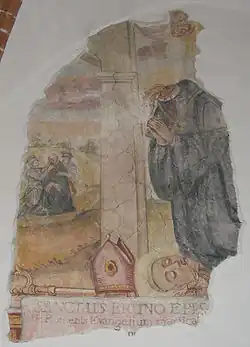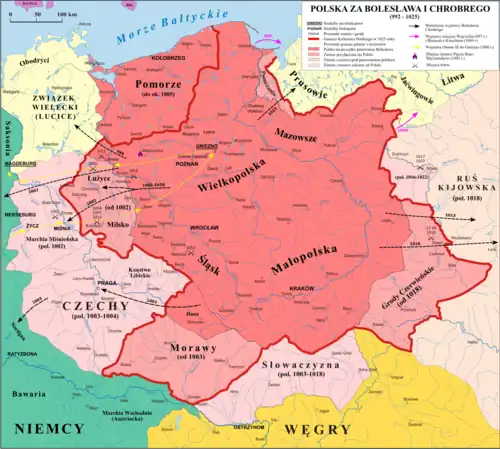Bruno of Querfurt
Bruno of Querfurt, O.S.B. Cam. | |
|---|---|
 A medieval fresco depicting St Bruno's death | |
| Bishop and Martyr; Second Apostle of the Prussians | |
| Born | c. 974 Querfurt, Holy Roman Empire (now in Saxony-Anhalt) |
| Died | 14 February 1009 Kievan Rus |
| Venerated in | Eastern Orthodox Church Roman Catholic Church (Camaldolese Order) |
| Feast | 15 October |
Bruno of Querfurt, O.S.B. Cam., (German: Brun von Querfurt; c. 974 – 14 February or 9/14 March 1009), also known as Brun, was a Christian missionary bishop, Camaldolese monk and martyr, who was beheaded near the border of Kievan Rus and Lithuania for trying to spread Christianity. He is also called the second "Apostle of the Prussians".
Biography
Early life
Bruno was from a noble family of Querfurt (now in Saxony-Anhalt). He is rumoured to have been a relative of the Holy Roman Emperor Otto III. Through his mother Matilda, he was related to the future Bishop of Merseburg, Thietmar, with whom he studied at the cathedral school in Magdeburg, the seat of Adalbert of Magdeburg, the teacher and namesake of Adalbert of Prague.[1] While still a youth, he was made a canon of the Cathedral of Magdeburg. The fifteen-year-old Otto III made Bruno a part of his royal court. In 995 Otto III appointed Bruno as one of his court chaplains.[2]
Despite having a clear path to a career at court and as a bishop, Bruno, perhaps influenced by the martyrdom of St. Adalbert, went to Rome and entered the monastery of St. Boniface and St. Alexius on the Aventine Hill.[3] It was then that he probably took the name Boniface, after the Anglo-Saxon missionary bishop who evangelized the Germanic tribes.[3] In 1001, Bruno entered a Benedictine monastery of Pereum, near Ravenna that Otto III had founded, and later underwent strict ascetic training under the guidance of Romuald.[4][3]
Missionary life
The emperor founded this monastery for the purpose of evangelizing the Slavs, and Bruno soon became involved in this endeavor. In agreement with the Polish prince Bolesław Chrobry, the brothers Benedict and John were sent to Poland, where they founded a monastery in Międzyrzecz for the purpose of evangelizing the Polabian Slavs.[3] Bruno was supposed to join them, but the death of the emperor and the ensuing turmoil prevented him from traveling to Poland. He stayed in Italy studying the language and awaiting the Apostolic appointment by Pope Sylvester II.[4] In addition, the monks from Międzyrzecz were murdered on the night of November 11-12, 1003, by opponents of Prince Bolesław.[5]
In 1003 Pope Sylvester II appointed Bruno, at the age of 33, to head a mission amongst the pagan peoples of Eastern Europe. Bruno left Rome in 1004, and having been named an archbishop was consecrated in February of that year by Archbishop Tagino of Magdeburg.[6] Owing to a regional conflict between the Holy Roman Emperor Henry II and Duke Boleslaus I of Poland, Bruno could not go directly to Poland so he set out for Hungary. There he went to the places that Adalbert of Prague had attended.
Bruno tried to persuade Ahtum, the Duke of Banat, who was under the jurisdiction of Patriarchate of Constantinople to accept the jurisdiction of the Bishop of Rome, but this precipitated a large controversy leading to organized opposition from local monks. Bruno elected to gracefully exit the region after he first finished his book, the famous "Life of Adalbert of Prague," a literary memorial giving a history of the (relatively recent) conversion of the Hungarians.[4]
After this diplomatic failure, Bruno went to Kyiv, where Grand Duke Vladimir I authorized him to make Christian converts among the Pechenegs, semi-nomadic Turkic peoples living between the Danube and the Don rivers.[4] Bruno spent five months there and baptized some thirty adults. He helped to bring about a peace treaty between them and the ruler of Kyiv.
Before leaving for Poland, Bruno consecrated a bishop for the Pechenegs. While in Poland he consecrated the first Bishop of Sweden and is said to have sent emissaries to baptize the king of Sweden,[7] whose mother had come from Poland. Bruno found out that his friend Benedict and four companions had been killed by robbers in 1003.[4] Bruno took eyewitness accounts and wrote down a touching history of the so-called Five Martyred Brothers.[8]
Mission to Prussia and death

In the autumn or at the end of 1008 Bruno and eighteen companions set out to found a mission among the Old Prussians; they succeeded in converting Netimer and then travelled to the east, heading very likely towards Yotvingia.
Bruno met opposition in his efforts to evangelize the borderland and when he persisted in disregarding their warnings he was beheaded on 14 February (or 9 or 14 March) 1009, and most of his eighteen companions were hanged by Zebeden, brother of Netimer.[8] Duke Boleslaus the Brave bought the bodies and brought them to Poland. (It was supposed that they were laid to rest in Przemyśl, where some historians place Bruno's diocese; such localization of Bruno's burial place is hardly probable because Przemyśl then belonged to Orthodox Kievan Rus through 1018.) The Annals of Magdeburg, Thietmar of Merseburg's Chronicle, the Annals of Quedlinburg, various works of Magdeburg Bishops, and many other written sources of 11th–15th centuries record this story.
Soon after his death, Bruno and his companions were venerated as martyrs and Bruno was soon after canonized. It was said that Braunsberg was named after Bruno.[4]
See also
References
- ^ Maciejewski 2010, p. 29.
- ^ "Šiūlys, Rimgaudas. "The Spirituality of St. Bruno of Querfurt", Lithuanian Historical Studies, 14, 2009, ISSN 1392-2343 pp. 1–10" (PDF). Archived from the original (PDF) on 2019-02-13. Retrieved 2019-02-13.
- ^ a b c d Maciejewski 2010, p. 30.
- ^ a b c d e f
 One or more of the preceding sentences incorporates text from a publication now in the public domain: Meier, Gabriel (1908). "St. Bruno of Querfurt". In Herbermann, Charles (ed.). Catholic Encyclopedia. Vol. 3. New York: Robert Appleton Company.
One or more of the preceding sentences incorporates text from a publication now in the public domain: Meier, Gabriel (1908). "St. Bruno of Querfurt". In Herbermann, Charles (ed.). Catholic Encyclopedia. Vol. 3. New York: Robert Appleton Company.
- ^ Maciejewski 2010, p. 31.
- ^ Duckett, Eleanor Shipley. Death and Life in the Tenth Century, University of Michigan Press, 1967, ISBN 9780472061723 p. 193
- ^ Bruno of Querfurt, baptism of king of Sweden
- ^ a b Butler, Alban. Lives of the Saints, Christian Classics, 1995
Bibliography
- A. Bumblauskas. Lithuania’s Millennium –Millennium Lithuaniae Or What Lithuania Can Tell the World on this Occasion. Lietuvos istorijos studijos, 2009, t. 23, p. 127–158.
- D. Baronas. ST BRUNO OF QUERFURT: THE MISSIONARY VOCATION. LITHUANIAN HISTORICAL STUDIES, 2009, t. 14. p. 41–52.
- Maciejewski, Jacek (2010). Średniowieczny misjonarz a millenium Litwy Bruno z Kwerfurtu i jego ostatnia misja (PDF). Językowe i kulturowe dziedzictwo Wielkiego Księstwa Litewskiego. Księga jubileuszowa na 1000‑lecie Litwy. Bydgoszcz.
- Wood, Ian (2014). "The Latin Hagiography of Mission from Rimbert to Bruno of Querfurt". The Cyril and Methodius Mission and Europe: 1150 Years Since the Arrival of the Thessaloniki Brothers in Great Moravia. pp. 34–39. ISBN 978-80-86023-51-9. OS LG 2023-08-18.
External links
- Saint Bruno Querfurt (in Italian)